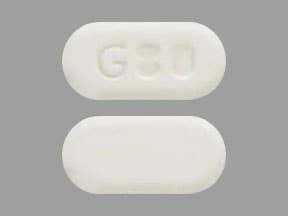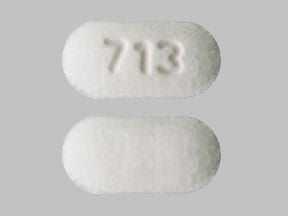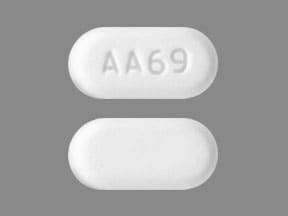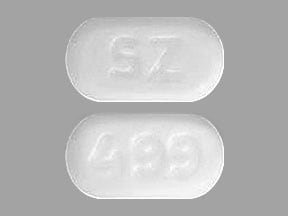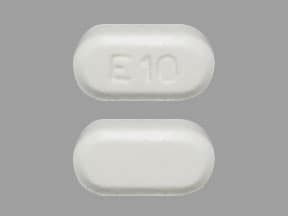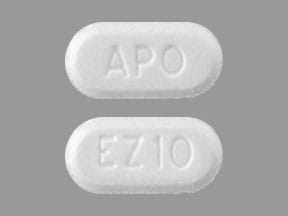Dosage Forms
Excipient information presented when available (limited, particularly for generics); consult specific product labeling.
Tablet, Oral:
Zetia: 10 mg
Generic: 10 mg
Pharmacology
Mechanism of Action
Inhibits absorption of cholesterol at the brush border of the small intestine via the sterol transporter, Niemann-Pick C1-Like1 (NPC1L1). This leads to a decreased delivery of cholesterol to the liver, reduction of hepatic cholesterol stores and an increased clearance of cholesterol from the blood; decreases total C, LDL-cholesterol (LDL-C), ApoB, and triglycerides (TG) while increasing HDL-cholesterol (HDL-C).
Pharmacokinetics/Pharmacodynamics
Metabolism
Undergoes glucuronide conjugation in the small intestine and liver; forms metabolite (active); may undergo enterohepatic recycling
Excretion
Feces (78%, 69% as ezetimibe); urine (11%, 9% as metabolite)
Onset of Action
Within 1 week; Maximum effect: 2-4 weeks
Time to Peak
Plasma: 4-12 hours (ezetimibe); 1-2 hours (active metabolite); Effects: ~2 weeks
Half-Life Elimination
22 hours (ezetimibe and metabolite)
Protein Binding
>90% to plasma proteins
Use in Specific Populations
Special Populations: Elderly
Plasma concentrations are approximately 2-fold higher.
Special Populations: Gender
Plasma concentrations for total ezetimibe were slightly higher (less than 20%) in women than in men.
Use: Labeled Indications
Homozygous familial hypercholesterolemia: In combination with a high-intensity statin (eg, atorvastatin) for the reduction of elevated total cholesterol (total-C) and low-density lipoprotein cholesterol (LDL-C) levels in patients with homozygous familial hypercholesterolemia as an adjunct to other lipid-lowering treatments (eg, LDL apheresis) or if such treatments are unavailable.
Homozygous sitosterolemia: As adjunctive therapy to diet for the reduction of elevated sitosterol and campesterol levels in patients with homozygous familial sitosterolemia.
Primary hyperlipidemia: As adjunctive therapy to diet and an HMG-CoA reductase inhibitor or as monotherapy if an HMG-CoA reductase inhibitor is not tolerated for the reduction of total-C, LDL-C, apolipoprotein B, and nonhigh-density lipoprotein cholesterol in patients with primary (heterozygous familial and nonfamilial) hyperlipidemia or mixed hyperlipidemia.
Use: Off Label
Secondary prevention of atherosclerotic cardiovascular events after acute coronary syndromea
Data from a multicenter, randomized, double-blind, placebo-controlled trial of patients with a recent acute coronary syndrome (ACS) support the addition of ezetimibe to statin therapy to reduce subsequent cardiovascular death, major coronary event (nonfatal myocardial infarction, unstable angina requiring hospitalization, or coronary revascularization within 30 days), or nonfatal stroke. Patients were eligible for this trial if ACS events occurred within 10 days and LDL cholesterol was ≥50 mg/dL) Cannon 2015.
Based on the 2018 AHA/ACC guideline on the management of blood cholesterol, the addition of ezetimibe to maximally tolerated statin therapy is effective and recommended for secondary prevention of atherosclerotic cardiovascular disease.
Contraindications
Hypersensitivity to ezetimibe or any component of the formulation; concomitant use with an HMG-CoA reductase inhibitor (statin) in patients with active hepatic disease or unexplained persistent elevations in serum transaminases; pregnancy and breastfeeding (when used concomitantly with a statin)
Dosage and Administration
Dosing: Adult
Note: Use may be considered in patients who do not meet cholesterol treatment goals with dietary modification and maximally-tolerated statin therapy (AHA/ACC [Grundy 2018]).
Homozygous familial hypercholesterolemia: Oral: 10 mg once daily.
Homozygous sitosterolemia: Oral: 10 mg once daily.
Primary hyperlipidemia: Oral: 10 mg once daily.
Secondary prevention of atherosclerotic cardiovascular events after acute coronary syndrome (off-label use): Oral: 10 mg once daily (Cannon 2015).
Dosing: Geriatric
Refer to adult dosing.
Dosing: Pediatric
Hyperlipidemia:
Children 5 to 9 years: Limited data available: Oral: 10 mg once daily; dosing based on two studies of monotherapy; a prospective trial (n=17 including six patients ≤9 years) and a retrospective review (n=36, age range: 8 to 17 years) showed significant decreases in total cholesterol and LDL-C; patients were followed up to a mean of 13.6 months, no untoward effects were noted (Clauss 2009; Yeste 2009)
Children ≥10 years and Adolescents: Oral: 10 mg once daily in combination with simvastatin. Has also been shown in small pediatric trials to decrease TC and LDL-C when used as monotherapy as adjunct to dietary changes (Clauss 2009; Yeste 2009)
Administration
May be administered without regard to meals. May be taken at the same time as a statin or fenofibrate. Administer ≥2 hours before or ≥4 hours after bile acid sequestrants.
Dietary Considerations
Before initiation of therapy, patients should be placed on a standard cholesterol-lowering diet for 6 weeks and the diet should be continued during drug therapy.
Storage
Store at 25°C (77°F); excursions are permitted between 15°C and 30°C (59°F and 86°F). Protect from moisture.
Ezetimibe Images
Drug Interactions
Bezafibrate: May enhance the adverse/toxic effect of Ezetimibe. Specifically, the risk of myopathy and cholelithiasis may be increased. Avoid combination
Bile Acid Sequestrants: May decrease the absorption of Ezetimibe. Management: Administer ezetimibe at least 2 hours before or 4 hours after any bile acid sequestrant. Consider therapy modification
CycloSPORINE (Systemic): Ezetimibe may increase the serum concentration of CycloSPORINE (Systemic). CycloSPORINE (Systemic) may increase the serum concentration of Ezetimibe. Monitor therapy
Eltrombopag: May increase the serum concentration of OATP1B1/1B3 (SLCO1B1/1B3) Substrates. Monitor therapy
Fenofibrate and Derivatives: May enhance the adverse/toxic effect of Ezetimibe. Specifically, the risk of myopathy and cholelithiasis may be increased. Monitor therapy
Gemfibrozil: May enhance the adverse/toxic effect of Ezetimibe. Specifically, the risk of myopathy and cholelithiasis may be increased. Gemfibrozil may increase the serum concentration of Ezetimibe. Avoid combination
Teriflunomide: May increase the serum concentration of OATP1B1/1B3 (SLCO1B1/1B3) Substrates. Monitor therapy
Tolvaptan: May increase the serum concentration of OATP1B1/1B3 (SLCO1B1/1B3) Substrates. Consider therapy modification
Adverse Reactions
1% to 10%:
Central nervous system: Fatigue (2%)
Gastrointestinal: Diarrhea (4%)
Hepatic: Increased serum transaminases (with HMG-CoA reductase inhibitors; ≥3 x ULN: 1%)
Infection: Influenza (2%)
Neuromuscular & skeletal: Arthralgia (3%), limb pain (3%)
Respiratory: Upper respiratory tract infection (4%), sinusitis (3%)
<1%, postmarketing, and/or case reports: Abdominal pain, anaphylaxis, angioedema, autoimmune hepatitis (Stolk 2006), cholecystitis, cholelithiasis, cholestatic hepatitis (Stolk 2006), depression, dizziness, erythema multiforme, headache, hepatitis, hypersensitivity reaction, increased creatine phosphokinase, myalgia, myopathy, nausea, pancreatitis, paresthesia, rhabdomyolysis, skin rash, thrombocytopenia, urticaria
Warnings/Precautions
Concerns related to adverse effects:
- Elevated hepatic transaminases: A higher incidence of elevated transaminases (≥3 x ULN) has been observed with concomitant use of ezetimibe and statins compared to statin monotherapy; transaminase changes were generally not associated with symptoms or cholestasis and returned to baseline with or without discontinuation of therapy. Consider discontinuation of ezetimibe and/or the statin for persistently elevated transaminases (ALT or AST ≥3 x ULN).
- Myopathy: Myopathy, including rhabdomyolysis, has been reported (rarely) with ezetimibe monotherapy; risk may be increased with concomitant use of a statin or fibrate. Discontinue ezetimibe and statin or fibrate immediately if myopathy is suspected or confirmed (symptomatic patient with CPK >10 x ULN).
Disease-related concerns:
- Hepatic impairment: Systemic exposure is increased in hepatic impairment. Use with caution in patients with mild hepatic impairment (Child-Pugh class A); use is not recommended in patients with moderate or severe hepatic impairment (Child-Pugh classes B and C).
- Renal impairment: Use with caution in patients with severe renal impairment (CrCl ≤30 mL/minute/1.73 m2); systemic exposure is increased ~1.5-fold. If using concurrent simvastatin in patients with moderate to severe renal impairment (CrCl <60 mL/minute/1.73m2), the manufacturer of ezetimibe recommends that simvastatin doses exceeding 20 mg be used with caution and close monitoring for adverse events (eg, myopathy).
Concurrent drug therapy issues:
- Drug-drug interactions: Potentially significant drug interactions may exist, requiring dose or frequency adjustment, additional monitoring, and/or selection of alternative therapy. Consult drug interactions database for more detailed information.
Other warnings/precautions:
- Hyperlipidemia: Secondary causes of hyperlipidemia should be ruled out prior to therapy.
Monitoring Parameters
ACC/AHA blood cholesterol guideline recommendations (ACC/AHA [Grundy 2018]; ACC/AHA [Stone 2013]):
Lipid panel (total cholesterol, HDL, LDL, triglycerides): Lipid profile (fasting or nonfasting) before initiating treatment. Fasting lipid profile should be rechecked 4 to 12 weeks after starting therapy and every 3 to 12 months thereafter (AHA/ACC [Grundy 2018]).
Hepatic transaminase levels: Baseline LFTs (reasonable); when used in combination with statin therapy, monitor LFTs when clinically indicated; discontinue use of ezetimibe if ALT elevations >3 times upper limit of normal persist. When used in combination with fenofibrate, monitor LFTs and signs and symptoms of cholelithiasis.
Pregnancy
Pregnancy Risk Factor
C
Pregnancy Considerations
Adverse events were observed in some animal reproduction studies. Use is contraindicated in pregnant women who require combination therapy with an HMG-CoA reductase inhibitor. If treatment for familial hypercholesterolemia is needed during pregnancy, other agents are preferred (Wiegman 2015).
Patient Education
What is this drug used for?
- It is used to lower cholesterol.
Frequently reported side effects of this drug
- Joint pain
- Diarrhea
- Loss of strength and energy
Other side effects of this drug: Talk with your doctor right away if you have any of these signs of:
- Muscle pain
- Muscle weakness
- Signs of a significant reaction like wheezing; chest tightness; fever; itching; bad cough; blue skin color; seizures; or swelling of face, lips, tongue, or throat.
Note: This is not a comprehensive list of all side effects. Talk to your doctor if you have questions.
Consumer Information Use and Disclaimer: This information should not be used to decide whether or not to take this medicine or any other medicine. Only the healthcare provider has the knowledge and training to decide which medicines are right for a specific patient. This information does not endorse any medicine as safe, effective, or approved for treating any patient or health condition. This is only a brief summary of general information about this medicine. It does NOT include all information about the possible uses, directions, warnings, precautions, interactions, adverse effects, or risks that may apply to this medicine. This information is not specific medical advice and does not replace information you receive from the healthcare provider. You must talk with the healthcare provider for complete information about the risks and benefits of using this medicine.
